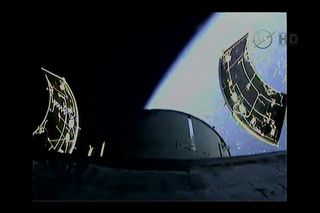
Orion Launch: Why the World Needs More Than One Mars Effort

This article was originally published at The Conversation. The publication contributed the article to Space.com's Expert Voices: Op-Ed & Insights.
After a 24-hour delay due to bad weather, the first test launch of the Orion spacecraft by NASA is underway with the ultimate goal of putting human beings on Mars.
Weeks after the landing on a comet by Rosetta’s Philae lander made news headlines around the world, solar system exploration remains firmly on the news agenda with the announcement of the crowd-funding LunarOne initiative and the European Space Agency’s Ministerial Council pledging funding for two Mars missions, the robotic ExoMars and the manned Orion spacecraft.
The Orion spacecraft developed by NASA is designed to take humans beyond low Earth orbit – where the International Space Station ISS resides – into deep space to destinations such as the moon, asteroids and ultimately Mars – although Mars is not on the cards until closer to 2030.
But what is so important about Mars, in particular, that ESA supports not one but two missions and wants to send humans to the Red Planet?
Looking for answers
Mars may hold some of the answers to “Where do we come from?” and “Where are we going?”. There is a lot of evidence that Mars was much more Earth-like in its early history with plenty of liquid water on its surface. These days, however, Mars is too cold and its atmosphere is too thin to allow liquid water to persist for any significant amount of time. Understanding why Earth and Mars went down such divergent evolutionary paths helps us to appreciate what is special about our own planet and to learn how to protect it.
Liquid water is the most important prerequisite of life. While Rosetta’s Philae lander looked for organics on comet 67P/Churyumov–Gerasimenko to get a better idea where the building blocks of life came from, wet early Mars is one of the few places in our solar system where life might have arisen from their assemblage.
Get the Space.com Newsletter
Breaking space news, the latest updates on rocket launches, skywatching events and more!
Compared to Jupiter’s icy moon Europa or Saturn’s moon Enceladus – other hotspots with the potential for life, Mars is by far the easiest to reach.

In addition, Mars is the only planetary body other than the moon within reach of manned space missions that offers the potential to establish a sustainable permanent outpost in the long run. This is why the Red Planet is at the centre of international exploration efforts as summarised, for example, in the Global Exploration Roadmap. This roadmap is a document drawn up by the International Space Exploration Co-ordination Group (ISECG). ISECG has 14 members, including NASA, ESA, the Russian, Chinese and Indian Space Agencies, and the UK Space Agency.
Complementary Mars missions
Although ExoMars and Orion share Mars as a common destination, they are very different in the timescales, in the scope of European involvement, and strategic importance. ExoMars consists of two missions. The Trace Gas Orbiter (TGO) and an Entry, Descent and Landing Demonstrator Module (EDM) will be launched in 2016, followed by a rover to be launched in 2018.
It is the funding for the rover that was negotiated during ESA’s ministerial council. The science goals are to search for signs of past and present life by studying trace gases such as methane and their sources with the orbiter, and by looking for organics in the subsurface with a drill system on the rover.

To share the costs of ExoMars, ESA has partnered with Russia, which provides the launchers for both missions and gets space on the orbiter and lander platforms for science instruments developed in Russia. Strategically, Europe wants to demonstrate that it can independently develop the technology to land on Mars to put it in a strong position as a partner in future sample return and eventually human missions to Mars. These will be so complex and expensive that they almost inevitably are going to be international in scope.
How such partnering can work is demonstrated by the Service Module to be provided by Europe for the US’s Orion spacecraft. The Service Module is based on one of Europe’s contributions to the International Space Station ISS: The unmanned Automated Transfer Vehicle (ATV) delivered cargo to the ISS.
Although ESA maintains its own astronaut corps, it has never developed an independent access for its astronauts to space. Plans to develop the ATV into a manned spacecraft were put on hold because of the high costs involved.
By partnering with NASA in the development of the Orion spacecraft, Europe may nevertheless be able to barter seats for its astronauts on future Orion expeditions.
This article was originally published on The Conversation. Read the original article. Follow all of the Expert Voices issues and debates — and become part of the discussion — on Facebook, Twitter and Google +. The views expressed are those of the author and do not necessarily reflect the views of the publisher. This version of the article was originally published on Space.com.
Join our Space Forums to keep talking space on the latest missions, night sky and more! And if you have a news tip, correction or comment, let us know at: community@space.com.
Most Popular


